You will never need another Dairy Free Blondies recipe after you taste this one! It is rich in sweet caramel flavor without being too sweet.
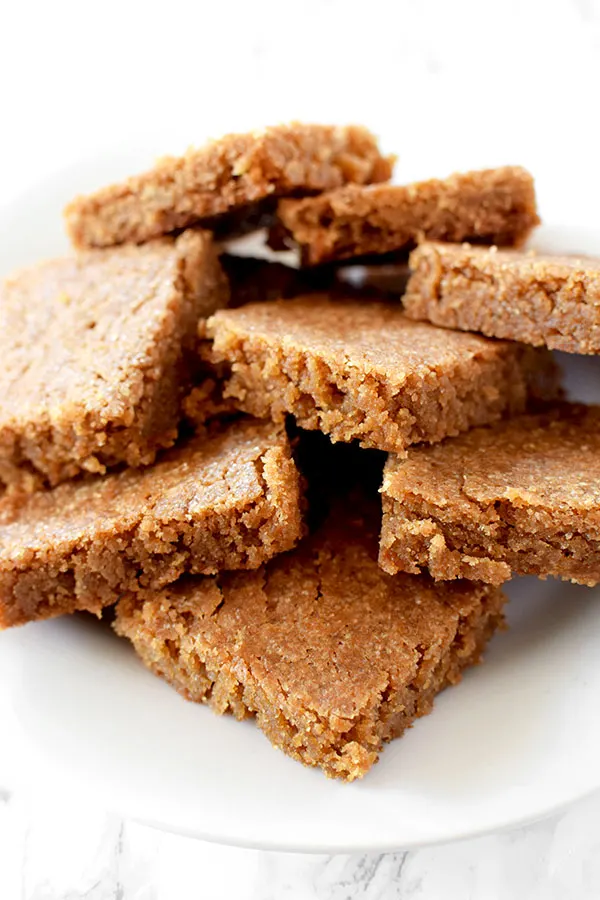
These blondies are chewy and so good you’ll never miss or wonder what you’re missing with buttered ones. I certainly don’t!
To be honest, I’ve always been more of a brownie type of dessert girl than a blondies. On top of that, I’m pretty particular about which brownies I am willing to waste calories on.
However, I have to admit, these blondies make me want to rethink my position.
While my brownies have a deep rich chocolate flavor, these blondies are addictive with their caramel flavor.
I also really enjoy their chewy texture, which I don't usually like as much in brownies.
Maybe it’s just me, but I think that makes blondies are perfect for autumn!
Of course, blondies are delicious all year round, but caramel makes me think of crisp air and changing leaves.
By the way, I think it is worth noting that while the history of blondies is unclear at this time, we do know blondies predated brownies by at least a decade.
In the 1800's, they were described as "dense, fudgy, butterscotch-flavored bar[s]."
CAKE FLOUR VS ALL-PURPOSE FLOUR
Cake flour is ideal for recipes where a light and fluffy texture is desired. It can be used to make cakes, cupcakes, muffins, quick breads, and even some cookies where a tender texture is required.
It is made from soft wheat varieties, which have a lower protein content compared to hard wheat. The low protein content creates very little gluten, which results in more tender and less dense baked goods with a delicate crumb.
Cake flour is finely milled, and the grains are smaller compared to all-purpose flour. This gives it a very fine texture, almost like powdered sugar, which contributes to the smooth and tender texture of cakes made with it.
I use all-purpose flour in all my recipes because it's easy to find and most people have it on hand.
Can I use self-rising flour instead of cake flour?
No. Self-rising flour is all-purpose flour that contains baking powder. You'd be better off simply using all-purpose flour.
HOW TO USE ALL-PURPOSE FLOUR INSTEAD OF CAKE FLOUR
If you have a recipe that calls for cake flour but want to use all-purpose flour instead, you can replace it cup for cup.
The cake will just have a slight difference in texture and crumb.
How to make your own cake flour
To make your own cake flour: for every cup of all-purpose flour, remove two tablespoons and replace it with two tablespoons of cornstarch.
So, for example, 2 cups of flour will become 1 ¾ cups of all-purpose flour and ¼ cup of cornstarch.
Replacing some of the flour with cornstarch removes enough protein to mimic the lower protein content of cake flour, resulting in a lighter cake with a more tender crumb.
How to Store Cake Flour
Like other flours, cake flour should kept in an airtight container to prevent absorption of moisture and be stored in a cool, dry place.
HOW TO MEASURE FLOUR AND OTHER DRY INGREDIENTS
The best way to measure dry ingredients is with a scale. However, this is not commonly done in the United States, where dry measuring cups are used instead.
To measure most dry ingredients, first spoon them into a dry measuring cup and then level off the measuring cup with an upside-down butter knife.
Make sure not to pack it down because it can lead to using more of the ingredient than called for.
The exception is brown sugar. To measure brown sugar, pack it into the measuring cup and then level off any excess.
To measure chocolate chips, nuts, or dried fruit, just pour them in and then level them off.
DRY VS LIQUID MEASURING CUP
Dry measuring cups are a set of cups that often come with measuring spoons. Each cup is a different measurement just like each spoon is a different measurement.
Liquid measuring cups, on the other hand, are cups that have measuring lines on the side to mark the measurements.
The problem with using liquid measuring cups to measure dry ingredients (like flour and cocoa) is that they are powders. So, as you shake the cup to level them off, the powders settle and you end up with more than you need.
I tested this with a friend who didn't believe me and we ended up with a number of tablespoons more than the recipe called for.
WHY sift Powdery Ingredients
There are a number of benefits to sifting powdery ingredients like flour and cocoa.
First of all, flour is often sifted before use to aerate it and remove any lumps. This helps in achieving a lighter texture in baked goods.
Secondly, if you measure flour that's just been sifted, you can get a more accurate measurement than from flour that's been packed tightly in a bag.
In addition, sifting dry ingredients together, such as flour, cocoa, and baking powder, helps make sure they're evenly dispersed.
BAKING WITH OIL
Baking with oil produces a moister and tenderer texture compared to that of baked goods made with butter.
Cakes, cupcakes, muffins, and quick breads also tend to bake up taller with a better crumb and stay moist and tender much longer than recipes made with butter.
Also, since oil weighs less than butter, baked goods made with oil have a lighter texture than those made with butter.
In addition, butter is usually only 80% fat, whereas oil is 100% fat. As a result, the water that's present in butter strengthens the gluten in the flour, making it more dense and less tender than baked goods made with oil.
Oil is often used in recipes where a lighter and airier texture is desired or in recipes that call for both oil and butter, in order to have the benefits of oil while keeping the butter flavor.
Which Type Of Oil to Use
I use neutral oils like canola oil, safflower oil, and vegetable oil. You can also use stronger oils like olive oil and coconut oil, but they may change the taste somewhat.
Is it better to use canola oil or olive oil?
Canola oil is relatively cheap and, due to its lack of flavor and high smoke point, is very versatile.
Olive oil, on the other hand, is healthier. Also, its stronger flavor makes it preferable in recipes such as focaccia, which require its distinct taste.
Baking with Oil Conversion Chart
If you want to convert your butter recipes to oil recipes, take a look at my baking with oil - butter to oil conversion chart.
How to store Oil
Store oils in a cool, dark place to prevent them from becoming rancid.
If refrigerated, some oils, like olive oil, may solidify, but will return to a liquid state at room temperature.
Coconut oil begins to solidify in temperatures under 76ºF or 25ºC.
BROWN SUGAR
What we call brown sugar is essentially white sugar that has had molasses added back to it.
It should not be confused with raw sugar or demerara, which are their own types of sugar.
You can easily substitute brown sugar or even make brown sugar.
Both dark and light brown sugar can easily be made at home if you have a little white sugar and molasses.
It is commonly used in chocolate chip cookie recipes, and it’s rare for a recipe that calls for brown sugar not to also call for white sugar as well.
When a recipe calls for “brown sugar” but doesn’t specify what type (light or dark), it is referring to light brown sugar.
DARK BROWN SUGAR
Dark brown sugar can be made with 1 cup white granulated sugar and 2 tablespoons molasses.
Add both ingredients into a bowl and mix with a fork until completely mixed.
LIGHT BROWN SUGAR
Light brown sugar can be made with 1 cup white granulated sugar and 1 tablespoon molasses.
Add both ingredients into a bowl and mix with a fork until completely mixed.
DEMERARA
Demerara is popular in Israel and is easier to find than light brown sugar. It is a type of cane sugar with a nice toffee flavor and can be used in place of brown sugar.
HOW TO SUBSTITUTE DARK AND LIGHT BROWN SUGAR
DARK BROWN SUGAR
Dark Brown Sugar can be made with 1 cup of light brown sugar and 1 tablespoon molasses.
Add both ingredients into a bowl and mix with a fork until completely mixed.
LIGHT BROWN SUGAR
Light Brown sugar can easily be replaced in a recipe with half dark brown sugar and half white granulated sugar.
DOES THE TYPE OF BROWN SUGAR YOU USE REALLY MATTER?
Using the wrong brown sugar will change the flavor and likely the color.
Dark brown sugar has more molasses, which will give it a deeper, more complex flavor that’s closer to toffee or caramel.
Light brown sugar is more subtle, which is sometimes ideal.
However, I tend to use what's on hand, which for me means dark brown sugar in Israel and light brown in the States.
I also happen to love the extra flavor dark brown sugar gives, so I like using it even if I have both on hand.
How to Store Brown Sugar
Store brown sugar in an airtight container to maintain its moisture and prevent it from hardening.
Types of Vanilla
Vanilla comes from a pod commonly known as a “vanilla bean”, which comes from the vanilla orchids.
Vanilla pods have been used for flavoring since the Aztecs and was introduced to Europe by a Spanish conquistador, along with cocoa.
Vanilla Extract
Vanilla extract is created by soaking vanilla beans in alcohol for some time. This is the most commonly used type of vanilla.
Vanilla Sugar
Vanilla sugar is common in Europe and some parts of the Middle East, like Israel.
It is made from vanilla beans sitting in sugar, vanilla bean powder mixed with sugar, or sugar mixed with vanilla extract.
In some countries, like Italy, you can also find vanilla powdered sugar, which is used for confections.
Vanilla Paste
Vanilla paste is generally a specialty item. It is a thick paste that contains a blend of the scraped-out vanilla pod seeds and vanilla extract.
You can use it as you do vanilla extract and it will leave flakes of vanilla bean like you see in vanilla bean ice cream.
Imitation Vanilla
Imitation Vanilla, otherwise known as artificial vanilla or vanilla essence, is made from synthetic vanilla.
This is the compound that naturally occurs in vanilla beans and gives it its flavor.
Can I use imitation vanilla?
Many will tell you that you should use high quality vanilla, just like they say you should use the best cocoa.
However, most of us will probably not be willing to pay the hefty price that comes with exceptionally high-quality ingredients.
Overall, vanilla is very expensive, so the extract is as well.
So, if you’re not going to get regular quality vanilla extract, you might as well use imitation vanilla.
Can vanilla extract be used as a substitute for vanilla beans?
Yes, vanilla extract can be used as a substitute for vanilla beans. Use about 1 teaspoon of vanilla extract for each inch of vanilla bean.
How to Store Vanilla
Pure vanilla extract and other vanilla products should be kept away from heat and light, and should be stored in an airtight container in a cool, dark place.
DO EGGS NEED TO BE AT ROOM TEMPERATURE?
The short answer is "no." While a side-by-side comparison shows that baking with eggs at room temperature makes a better crumb, it’s not otherwise noticeable.
What are Eggs used for?
Eggs do three things in most recipes: they help bind the ingredients together, act as a mild leavening agent, and they add moisture.
ARE EGGS DAIRY?
No, eggs are not dairy. Dairy is milk and any food products made from milk, including cheese, cream, butter, and yogurt.
So, while eggs are an animal product, they are not dairy. In fact, eggs fall under the protein food group.
How to tell if your eggs are still good
Fill a glass with cool water and submerge the eggs.
If the eggs sink to the bottom and lay flat on their side, they're still fresh.
If they sink, but stand on one end at the bottom of the glass, the eggs are not as fresh but still good.
An egg that floats to the top is likely spoiled.
EGGLESS OPTION
Eggs can be substituted with ¼ cup of unsweetened apple sauce per egg. This means that for recipes calling for 2 eggs, you’d need ½ cup of unsweetened apple sauce.
The reason applesauce makes a good binder is that it's high in pectin. Pectin is a naturally occurring starch in fruits and berries that acts as a thickening agent and stabilizer in food.
This happens when combined with sugar and acid (if the fruit or berry isn't naturally acidic).
Just keep in mind that it may change the flavor slightly.
BAKING SODA VS BAKING POWDER
Both baking soda and baking powder are leavening agents, which means that they help baked goods rise. However, they're not the same thing and they are not interchangeable.
Using baking soda instead of baking powder can give your recipe a terrible metallic taste, while using baking powder instead of baking soda leaves your baked goods looking flat.
BAKING SODA
When baking soda (also known as sodium bicarbonate) is combined with acidic ingredients and exposed to heat, it causes batter or dough rise and contributes to their light and fluffy texture.
However, baking soda is a versatile ingredient. It can be sprinkled over meat to tenderize it and it can be added to tomato sauce to neutralize the acidity.
Baking soda, when combined with an acid - such as cream of tartar, lemon juice, buttermilk, cocoa, and vinegar - creates carbon dioxide. When the carbon dioxide is released, it causes the familiar texture and crumb in pancakes, cakes, quick breads, soda bread, and other baked and fried foods.
A good rule of thumb is to use around ¼ teaspoon of baking soda per 1 cup of flour.
BAKING POWDER
Baking powder is created by combining baking soda, cream of tartar, and sometimes cornstarch.
Since baking powder already contains an acid, it's most often used when a recipe does not call for an additional acidic ingredient or calls for too little of one.
There are two types of baking powder. Single-acting baking powder and double-acting baking power.
Single-acting baking powder gets activated only once - when it gets wet.
Most baking powder sold is double-acting. This means that the leavening occurs in two steps.
The first is when the baking powder gets wet, which is why you cannot prepare some batters ahead of time to bake later. The second step is when the baking powder is exposed to heat, which happens when the batter is baked or fried.
A good rule of thumb is to use around 1 teaspoon of baking powder per 1 cup of flour.
WHY SOME RECIPES CALL FOR BOTH
Some recipes use both baking soda and baking powder because they need extra leavening that the baking soda alone cannot provide.
In these cases, baking soda provides an initial lift, while baking powder provides additional rise.
WHICH ONE IS STRONGER?
You may have already guessed the answer since baking soda is used to make baking powder and you need more baking powder per cup of flour. But I’ll tell you anyway.
Baking soda is four times stronger than baking powder.
That's why you will, more often than not, see recipes that only call for baking soda rather than recipes that only call for baking powder.
HOW LONG DO THEY LAST?
BAKING SODA
Baking soda is good indefinitely past its best by date, although it can lose potency over time.
A good rule of thumb is two years for an unopened package and six months for an opened package.
However, to be honest, I’ve used very old baking soda with good results.
BAKING POWDER
Like baking soda, baking powder is good indefinitely past its best by date, and can lose its potency over time.
For both opened and unopened, it’s ideal to use it within nine months to a year.
While storing it, make sure to keep it in a dry place and away from humidity.
HOW TO TEST IF IT’S STILL GOOD
BAKING POWDER
To test baking powder, pour 3 tablespoons of warm water into a small bowl, add ½ teaspoon of baking powder, and stir.
If the baking powder is good to use, it should fizz a little.
BAKING SODA
To test baking soda, pour 3 tablespoons of white distilled vinegar into a small bowl, add ½ teaspoon of baking soda, and stir.
The mixture should rapidly bubble if the soda is fresh.
GLUTEN FREE OPTION
Gluten Free Flour
Substitute all-purpose gluten-free flour in place of all-purpose regular flour cup for cup.
BUCKWHEAT FLOUR
Buckwheat flour is easy to find compared to most other gluten-free flours, and it adds a nice earthy nutty taste.
The downside is that it has a distinct flavor, so the change will be noticeable.
It’s also darker, so the color won’t be the same. Substitute cup for cup.
RICE FLOUR
Rice flour can also be used and can be found in most Asian and health food stores.
White rice flour has a mild flavor and doesn’t change the color of the muffin or quick bread.
Since it doesn’t have much flavor, it's best to use it with ingredients that do. Substitute cup for cup.
OAT FLOUR
Oat flour is made from whole oats that have been ground into a powder, which can easily be done at home.
It gives more flavor and a chewier and crumblier texture than regular all-purpose flour.
Substitute 1 cup of all-purpose flour for 1 ⅓ cup oat flour. To make 1 cup of oat flour, blend 1 ¼ cups of oats in a food processor until finely ground.
Note: oats must be marked gluten-free because they can get cross-contaminated in the factory.
Baking with Humidity
Humidity can have a big impact on how your baked goods come out.
This is because when humidity is extremely high (think 70 percent or more), baking ingredients like flour, sugar, salt, baking powder, and baking soda soak up moisture from the air.
This can negatively impact the outcome of your cakes, cookies, yeast breads, and quick breads.
There are some things you can do to try to save your baking.
Try to counterbalance the additional moisture
To help counterbalance the additional moisture your dry ingredients soak up from the air, try reducing the amount of liquid in the recipe by about one quarter.
If the batter or dough looks too dry once all the ingredients are mixed together, add additional liquid a tablespoon at a time until you have the desired consistency.
This is not usually possible to do for cookies, but it does work for cakes and breads.
Store Ingredients in the Fridge
If flour and sugar are stored in the refrigerator or freezer rather than in a cupboard or pantry, they are better protected from humidity.
As an added benefit, keeping these ingredients cool also helps keep them fresher longer, in addition to helping them stay bug-free.
For the best results, let them warm to room temperature before using.
Bake for Longer
If you bake your goodies for a few extra minutes, it can help the liquid to cook off.
To avoid overbaking, continue testing for doneness every couple of minutes for breads, quick breads, cakes, cupcakes, and muffins. Cookies, on the other hand, need to be checked every minute.
Use Air Conditioning
To help lower humidity levels on humid summer days, air condition the room for at least an hour before you start baking.
Cooler air isn’t able to hold as much moisture as warm air.
Store your baked goods in an airtight container
Humidity can also ruin your fresh-baked goods because when they are left out, they can absorb moisture.
To avoid this, store them in an airtight container or resealable bag.
Adjusting for a Convection Oven
Convection ovens blow the hot air around, producing around 25 to 30 percent more heat.
Since convection ovens produce more heat, you need either lowering the temperature or shortening the cooking time to compensate.
When recipes specify temperatures and cooking times, it’s for conventional ovens, unless specified otherwise.
A simple rule to follow is to lower the temperature by 25ºF or 14ºC when baking cookies and pies, and 50ºF or 28ºC when roasting meat and poultry. Some convection ovens offer separate settings for baking and for roasting.
You can also leave the temperature the same and instead, shorten the cooking time by 25 percent. For example, if your recipe calls for 60 minutes in the oven, check the food after 45 minutes instead.
However, keep in mind, some convection ovens actually make a heat adjustment for you. That is, if you set a convection oven for 350ºF, it might actually set itself to 325ºF to compensate. So, check your manual before making adjustments.
HOW TO DOUBLE THE RECIPE
If you double the recipe, you will need a 9 x 13-inch pan.
The area of a square or rectangular pan is calculated by multiplying one side by the other side.
This recipe calls for an 8-inch square pan so an 8 x 8 = 64 square inches where a 9 x 13 = 117 square inches. If you double the 8 x 8-inch pan, it would come out to 128 square inches, which is close enough to 117 square inches.
TROUBLESHOOTING
WHY IS IT TAKING LONGER THAN DESCRIBED TO BAKE?
Over time, the thermostat on ovens gets a little off, causing some ovens to run hot and others to run cool. This is why recipes tend to say things like “10 to 15 minutes or until golden brown.” So, if it takes you longer than expected, that’s fine, don’t worry about it. Just keep baking until ready.
WHY DID MY RECIPE COME OUT TOO DRY?
Just like some ovens run cool, others run hot. If your oven runs hot, bake these at a lower temperature. Ideally, you should get an oven thermometer to know what temperature you’re really baking at.
HOW TO STORE
For a whole pan, wrap well in plastic wrap or in an airtight plastic storage bag. Keep at room temperature for up to four days.
For cut blondies, wrap individually with plastic wrap. Store in an airtight container or an airtight plastic bag. Keep at room temperature for one to two days.
HOW TO FREEZE
Wrap cooled, uncut blondies tightly in a plastic wrap. Wrap again in aluminum foil. Freeze for up to 3 months. After 3 months, they are still safe to eat but the quality begins to degrade.
Dairy Free Blondies
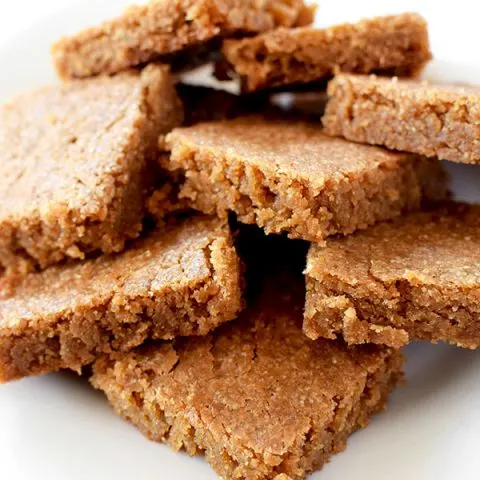
Blondies are a great alternative to brownies, and since they don't have any cocoa, they really let the caramel flavor shine.
Ingredients
- 1 cup of all-purpose flour (120 grams)
- 1 cup brown sugar, packed (210 grams)
- 1 teaspoon baking powder
- ½ teaspoon salt
- 1 egg
- ⅓ cup oil (80 milliliters)
- 1 tablespoon vanilla
Instructions
- Preheat the oven to 350°F or 175°C.
- Whisk together flour, brown sugar, baking powder, and salt in a mixing bowl.
- Add the oil, egg, and vanilla extract and mix using a baking spatula. It should look almost like a dough.
- Pour into an 8 x 8 inch pan (20 cm x 20 cm) lined with parchment paper and spread evenly.
- Bake for 25-30 minutes. Allow to cool before cutting.
Recommended Products
Some of the links below are affiliate links, which means that if you choose to make a purchase, I will earn a small commission. This commission comes at no additional cost to you.
Nutrition Information:
Yield:
9Serving Size:
1Amount Per Serving: Calories: 213Total Fat: 9gSaturated Fat: 1gTrans Fat: 0gUnsaturated Fat: 8gCholesterol: 21mgSodium: 186mgCarbohydrates: 31gFiber: 0gSugar: 20gProtein: 2g
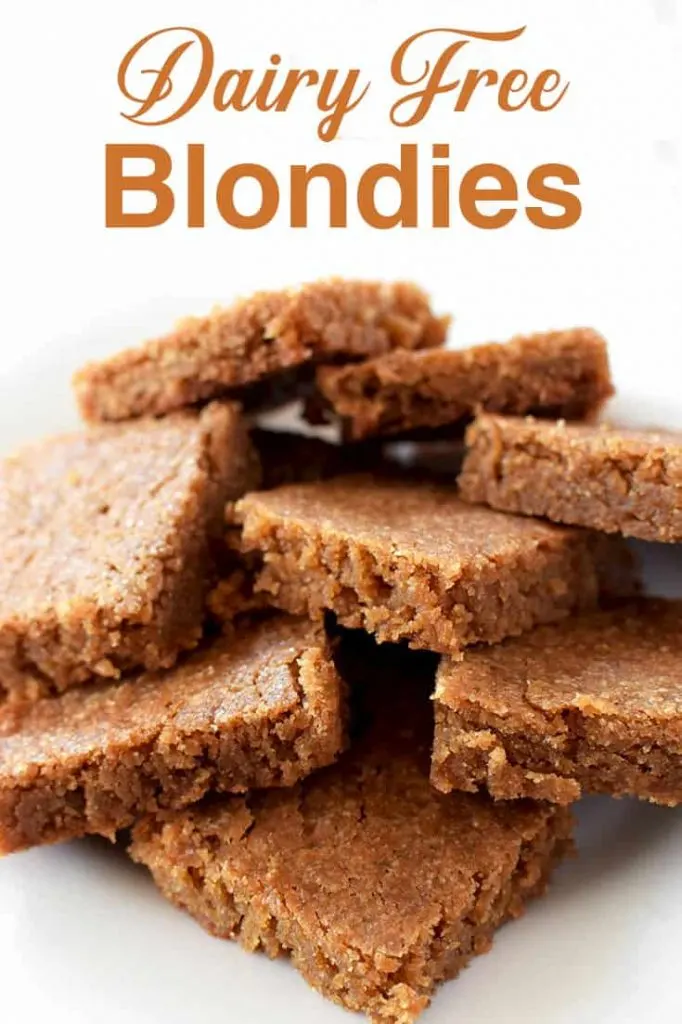
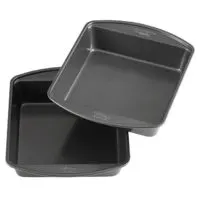
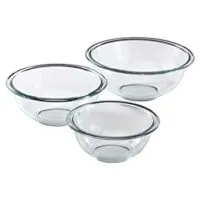
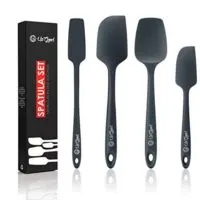
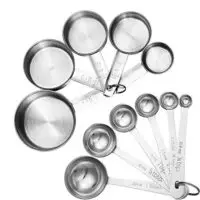
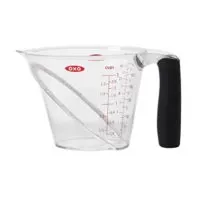
Mark
Thursday 8th of September 2022
Honestly when I made the dough I was a little skeptical. Just looked like a very dense, oily cookie dough. I was ready for disappointment.
But they turned out beautifully. So delicious. The wife and kids loved them. I should never have doubted you, internet recipe stranger.
ElissaBeth
Thursday 8th of September 2022
I am very glad to hear you liked them and that they didn't disappoint :)
Jennifer
Saturday 1st of May 2021
Wow, I'm so impressed at all the additional information on baking ingredients and how they're used and suitable substitutions! Thank you so much! I'm going to try these tomorrow and use lemon instead of vanilla, coconut sugar and a 3/4 cup rice/ 1/4 cup tapioca flour mix to make them gluten free and see what happens. Thanks again :)
ElissaBeth
Monday 3rd of May 2021
You're very welcome :) I hope you enjoy the recipe
Haley
Wednesday 9th of December 2020
My roommates and I loved these! I added a bit of flaky salt on top and switched half the vanilla for maple syrup (1/2 tbsp maple, 1/2 tbsp vanilla). Easy to make and delicious!
ElissaBeth
Thursday 10th of December 2020
I'm glad to hear it :)
Shira Herskovitz
Monday 11th of February 2019
Super easy and delicious! They are soft and chewy. love these!!!
ElissaBeth
Tuesday 12th of February 2019
Thank you so much Shira!
Chana Ben-Shimon
Friday 23rd of November 2018
I made Blondies and Brownies as one of my desserts yesterday for Thanksgiving.. They were a hit! Im so glad I doubled up the recipe! 10 stars!! Toda raba!
ElissaBeth
Sunday 25th of November 2018
I am thrilled to hear that Chana! Thank you so much for telling me! It made my day :)